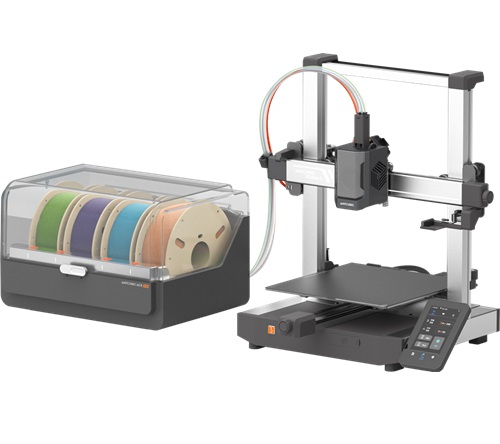Compare Kobra 3 Combo vs Ender 5
Comparison between the best 3D printers
Choose the best 3D printer at the best price. The cheapest 3D printers are here.
Buy a 3D printer here with 3D Fila.
 |
 |
|
| Model | Kobra 3 Combo[BUY Kobra 3 Combo] |
Ender 5[BUY Ender 5] |
| Printing Material | Filament | Filament |
| Buy Filament for Anycubic Kobra 3 Combo | Buy Filament forCreality 3D Ender 5 | |
| Estimated price | $349,00 | $399,00 |
| Manufacturer | Anycubic | Creality 3D |
| Release Year | 2024 | 2020 |
| Print Volume [mm] | 250x250x260 | 220x220x300 |
| Printer Size [mm] | 452x504x483 | 485x510x552 |
| Weight [kg] | 9,2 | 11,8 |
| Power Loss Recovery | YES | YES |
| Enclosed printer | NO | NO |
| Bed Leveling | Automatic | Manual |
| Filament End Sensor | YES | NO |
| Bed type | Heated | Heated |
| Power supply system | Direct Drive | Bowden |
| Standard nozzle | 0,4 | 0,4 |
| Maximum Nozzle Temperature [°C] | 300 | 255 |
| Maximum Bed Temperature [°C] | 110 | 100 |
| Maximum printing speed [mm/s] | 600 | 180 |
| Filament holder | YES | YES |
| Camera for supervision | NO | NO |
| Recommended filaments | PLA, PETG, ABS, PP, HIPS | PLA, TPU, ABS, PETG |
| Recommended slicers | Anycubic Slicer, Cura, Orca Slicer | Cura, Simplify, Slic3r |
| Maximum Resolution [mm] | 0,1 | 0,1 |
| Processor | 32 bits | 32 bits |
| Display | Touchscreen 4,3'' | Mono |
| Power Supply | 400 W | 24V / 360W |
| Connectivity | USB, Wi-Fi, Cloud | SD / USB |
| Operating systems | Windows, Linux, Macbook | Windows, Mac, Linux |
| Date of registration in the system | 2024-06-27 | 2021-04-15 |
| Release date | 2024 | 2020 |
| Extra features | The Anycubic Kobra 3 Combo offers advanced features, including multi-filament printing with the ACE (Anycubic Color Engine) system, allowing for quick switching of up to four filaments. It features automatic bed leveling, nozzle clogging detection, and integrated filament drying during printing. The printer supports technical materials such as ABS, ASA, Nylon, and PC, thanks to the hotend that reaches 300°C and the heated bed up to 110°C. In addition, it has a 4.3-inch touchscreen and compatibility with various slicers such as Anycubic Slicer, Cura, and Orca Slicer. | Crealitys Ender 5 stands out with a solid frame and a larger 220 x 220 x 300mm print volume. Its assembly is simple and quick, offering high print quality and speeds of up to 80mm/s. With a magnetic bed, it makes it easy to remove prints. Notable for being hackable and expandable, the Ender 5 continues Crealitys innovative tradition in the affordable 3D printer market. Equipped with a 350W/24V Meanwell power supply, it heats up quickly, in addition to having efficient cable management and modified Marlin firmware. Its unique design includes dedicated stepper motors for each axis and smooth movement on the Y axis, providing more consistent and detailed prints. |
| Support for multiple colors and materials (AMS and CFS) | YES | NO |
Notes * |
||
| Cost-benefit | 8 / 10 | 7 / 10 |
| Hardware | 4 / 10 | 1.5 / 10 |
| Tela | . | . |
| Print volume | 4 / 10 | 3 / 10 |
| Performance | 5 / 10 | 1 / 10 |
| [BUY Kobra 3 Combo] | [BUY Ender 5] |
Conclusion |
| When comparing the Kobra 3 Combo and the Ender 5, several factors influence the choice of the best 3D printer for your needs. The Kobra 3 Combo, released in 2024, offers modern features such as automatic bed leveling, a filament end sensor, and multi-filament printing capabilities, making it ideal for users looking for ease and versatility in their printing projects. Its larger maximum nozzle temperature and improved printing speed allow it to handle a wider variety of advanced materials while achieving higher quality prints. In contrast, the Ender 5, although older, has a proven track record with a solid frame and straightforward assembly process. It provides a decent print volume and is known for its hackability, allowing for user modifications and upgrades. While it has a weaker feature set compared to the Kobra 3 Combo, many users appreciate its reliability and quality at a more affordable price point. Considering the cost-benefit ratio, the Kobra 3 Combo stands out with stronger performance and advanced functionality, while the Ender 5 appeals to those looking for a budget-friendly option that still delivers quality prints. Ultimately, the choice between these two printers should be based on your specific requirements and preferences regarding features, material compatibility, and budget constraints. |

